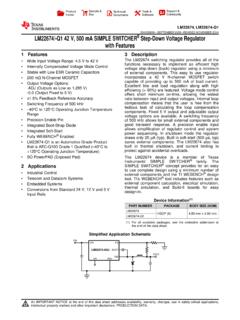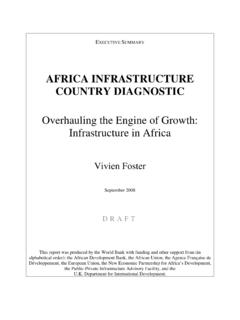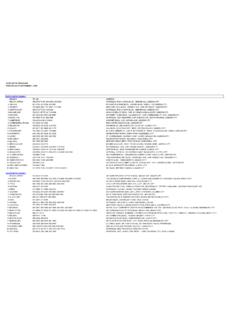Transcription of Effective Police Interactions with Youth: Training Evaluation
1 Effective Police Interactions with youth : Training Evaluation Full Report Prepared for the State of connecticut Office of Policy and Management March 2008 CENTER FOR APPLIED RESEARCH IN HUMAN DEVELOPMENT UNIVERSITY OF CONNECTICUTPage 1 Effective Police Interactions with youth March 2008 Prepared for: The State of connecticut Office of Policy and Management 450 Capitol Avenue Hartford, CT 06106-1379 Prepared by: The Center for Applied Research in Human Development 843 Bolton Road, U-1117 Storrs, CT 06269 The work described in this document was supported by the State of connecticut Office of Policy and Management.
2 Please direct inquiries to Dr. Stephen Anderson at the Center for Applied Research in Human 2 The Center for Applied Research in Human Development is a joint venture between the department of Human Development and Family Studies, in the College of Liberal Arts and Sciences, and Cooperative Extension System in the College of Agriculture and Natural Resources. The Center provides assistance to state and community-based agencies in the development, delivery, and Evaluation of human service programs. The primary focus is on promoting high quality educational programming and Evaluation for programs that promote child, youth , and family development.
3 Recent advances in theory and research are applied in the planning and implementation of all Center initiatives. The Center also provides hands on opportunities for students to learn practical research and Evaluation skills in a variety of human service, prevention, and community education programs. The Center for Applied Research in Human Development is the recipient of the 2006 Outreach Recognition Award granted by the University of connecticut , Office of the Provost, as an Outstanding Example of a Programmatic University Resource. Effective Police Interactions with youth is the final report based on data collected for the Evaluation of the Effective Police Interactions with youth project.
4 The views, findings, conclusions, and recommendations expressed herein are those of the authors and do not necessarily express the viewpoint of the State of connecticut Office of Policy and Management. Authors Jessica Sanderson, Iva Kosutic, Julie Griggs, Stephen Anderson Principal Investigator Stephen A. Anderson, Study Team The Center for Applied Research in Human Development Jessica Sanderson, Iva Kosutic, Jennifer Trachtenberg, Julie Griggs, , Page 3 TABLE OF CONTENTS INTRODUCTION .. 4 BACKGROUND .. 4 THE Effective Police Interactions with youth PROJECT .. 4 ORGANIZATION OF THE REPORT .. 5 PART I: STUDY DESIGN.
5 6 STUDY DESIGN .. 6 MEASUREMENT .. 6 DATA COLLECTION .. 8 PARTICIPANTS .. 9 PART II: RESULTS .. 12 CHANGES IN PARTICIPANTS KNOWLEDGE .. 12 CHANGES IN PARTICIPANTS ATTITUDES .. 14 SUBGROUP COMPARISONS AMONG PATROL OFFICERS WHO COMPLETED THE Training 21 PARTICIPANTS REACTIONS TO THE Training PROGRAM .. 21 PART III: CONCLUSIONS AND RECOMMENDATIONS .. 24 REFERENCES .. 26 APPENDIX A .. 27 APPENDIX B .. 33 APPENDIX C .. 40 WHAT DID YOU LIKE MOST ABOUT THE PROGRAM? .. 40 WHAT DID YOU DISLIKE ABOUT THE Training ? .. 42 WHAT SPECIFIC CHANGES WOULD YOU MAKE TO IMPROVE THE Training ? .. 43 Page 4 INTRODUCTION BACKGROUND In 2001, the connecticut Juvenile Justice Advisory Committee (JJAC) published a study entitled A Reassessment of Minority Overrepresentation in connecticut s Juvenile Justice System1 to examine the extent of disproportionate minority contact (DMC) in the state.
6 DMC is a national term that refers to the problem of unequal treatment of White and minority juveniles in the juvenile justice system. The JJAC study focused on overrepresentation of minority youth in the system and disparate handling of minority youth at key decision points. To address study findings at the earliest Police decision points, the JJAC created a task group, comprised of primarily Police personnel, to look into issues that would affect Police handling of juveniles prior to written Police incident reports. A key issue that was identified by the task group was that many patrol officers, as opposed to youth officers, lack the knowledge they need to differentiate problematic adolescent behavior from typical adolescent behavior and the practical skills to de-escalate situations involving agitated or defiant youth .
7 The task group further concluded that patrol officers should be taught to interact more effectively with all young people, regardless of their race or background, rather than simply focusing on diversity Training . THE Effective Police Interactions with youth PROJECT The Effective Police Interactions with youth Training program is designed to address this gap in knowledge and skills among patrol officers. The Training purpose is to reduce the likelihood that Interactions between Police officers and young people will have negative outcomes and/or result in Police action, particularly for minority youth . The goals of the Training program are: Increase patrol officer awareness of disproportionate minority contact (DMC); Increase patrol officer knowledge of youth behavior and strategies for interacting effectively with youth ; Improve Police attitudes toward young people; Increase the likelihood that Police / youth Interactions will have positive outcomes for youth ; and Increase the likelihood that youth will respond positively toward Police officers.
8 The Training program is designed for delivery by certified Police trainers in a classroom setting. Trainers use a variety of instructional techniques including slide presentations, video clips, class discussions, small group activities, and individual activities. This creates an interactive Page 5 environment that builds on participants existing knowledge and provides opportunities for them to share and learn from each other. The Training was offered in connecticut in March and April of 2007, following two rounds of pilot testing in the latter part of 2006. A total of 21 one-day Training sessions were offered. This report summarizes the results of an Evaluation study that assessed the effectiveness of this new Training curriculum.
9 The Evaluation was conducted by the Center for Applied Research in Human Development (CARHD) at the University of connecticut . ORGANIZATION OF THE REPORT This report consists of several parts. The first part provides a description of (a) the research design used to evaluate the Effective Police Interactions with youth project, (b) the measurement tool designed to assess patrol officers knowledge, attitudes, and satisfaction with the Training , (c) data collection procedures, (d) Training and control groups, and (e) data analysis strategies. The second part of the report details the results of the Evaluation , including (a) changes in participating patrol officers knowledge over time, (b) changes in participating patrol officers attitudes over time, (c) comparisons between the Training group and the control group, (d) subgroup comparisons among patrol officers who completed the Training , and (e) participating patrol officers satisfaction with the Training .
10 The third part of the report contains a summary and recommendations for future evaluations. Page 6 PART I: STUDY DESIGN STUDY DESIGN This project used an experimental design to assess changes in patrol officers knowledge and attitudes towards youth following a one-day Training program. A total of 468 officers from various Police departments throughout the State of connecticut were selected to participate in this Evaluation project. Thirty-three local Police departments in connecticut volunteered to participate in the Training and Evaluation component of the Effective Police Interactions with youth Training program.


















